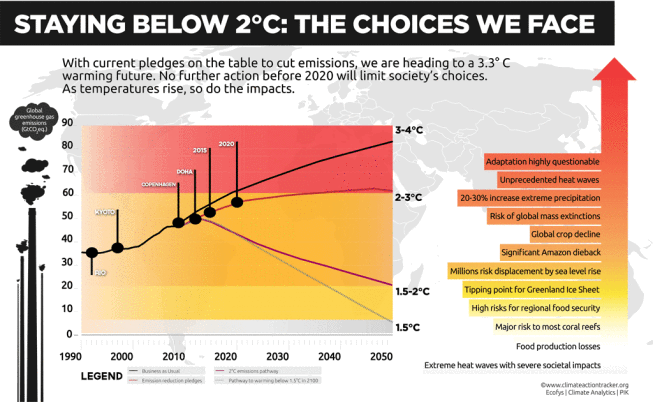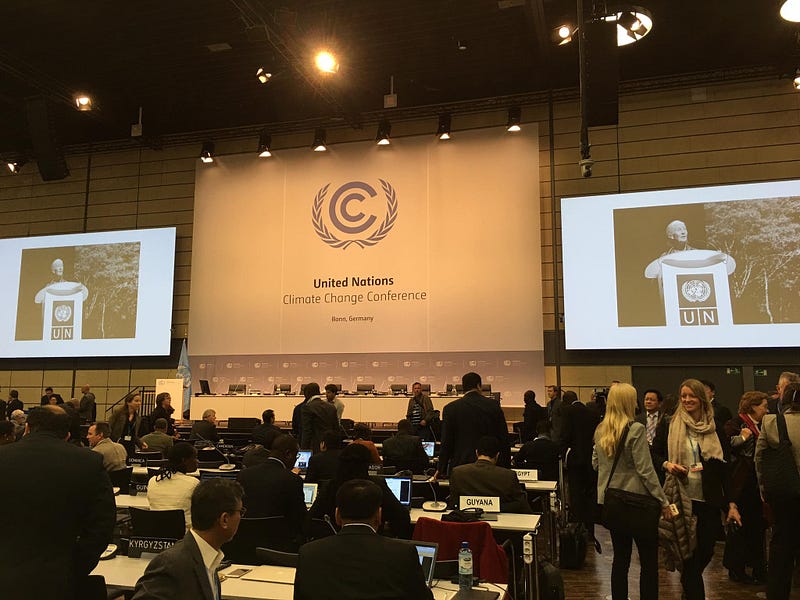Several members of the Georgetown University community will attend the U.N. Climate Change Conference which began Monday, November 7th. In collaboration with McCourt’s Energy and Environment Association, GPPR will be bringing you reporting and analysis from the conference.
Climate change. It’s a thing we all kind of know something about but maybe it’s a long way off, maybe it’s unclear how it would affect us, or maybe it just seems too insurmountable or expensive to fix. We’ll figure something out. Some new technology will save us, right?
While the human innovative capacity knows no bounds, leaving any serious issue to chance is never practical. Addressing climate change’s near and long-term challenges with a rigorous policy framework is a common-sense goal. Unavoidable large-scale financial and societal costs will occur despite best efforts from some U.S. legislators to bury their heads in the sand. The question now is not whether these costs will be incurred but to what order of magnitude based upon which maximum temperature scenario we reach. It is in the interest of the United States to work closely with the international community in this effort. As outlined by our Department of Defense in a 2015 report “National Security Implications of Climate-Related Risks and a Changing Climate,” the Pentagon describes how climate change “will have wide-ranging implications for U.S. national security interests over the foreseeable future because it will aggravate existing problems — such as poverty, social tensions, environmental degradation, ineffectual leadership, and weak political institutions — that threaten domestic stability in a number of countries.”
Thankfully, the international community is doing something to address climate change and, in recent years, the U.S. has taken a leadership role. For twenty two years, almost every country in the world has been meeting at annual Conferences of the Parties (COPs) to the United Nations Framework Convention on Climate Change (UNFCCC). The historic Paris climate Agreement was reached last year at the 21st COP meeting (COP21). The next international climate conference, COP22, started today in Marrakech, Morocco and will run through next Friday, November 18. It is the work that occurs under the UNFCCC framework that will enable us to ensure society has a fighting chance to be put on a sustainable climate path while addressing the many challenges we will face along the way.
Last year, I wrote a blog on what to expect from the Paris climate negotiations that claimed “no one expects an agreement that would keep average global temperature from rising more than 2 degrees Celsius.” Not an expert on international climate negotiations, but hoping to learn more, I will admit that I got a few things wrong in that post. The final agreement, signed by 191 countries, commits signatory Parties to “hold the increase in the global average temperature to well below 2°C above pre-industrial levels and to pursue efforts to limit the temperature increase to 1.5°C above pre-industrial levels, recognizing that this would significantly reduce the risks and impacts of climate change.”
Getting 191 countries to agree to hold global average temperature to 1.5°C-2°C above pre-industrial levels by 2100 is the historic part of the Agreement. Especially since scientific climate modeling shows how difficult this will be given our current trajectory. However, I stand by my claim that the Paris Agreement did not in fact achieve this goal — not yet at least. The sum of all individual country’s climate plans still get us to roughly 3°C by 2100. International cooperation the likes of which the world has never seen will be required to “bend the curve” from 3°C down to between 1.5°C-2°C. All 191 countries know this and they plan to evaluate, monitor, report, and strengthen their climate commitments in a continuous manner until they hit their targets. These points basically form the heart of the international negotiating structure.

In May of this year, I attended the Bonn, Germany climate change conference and experienced my first taste of the negotiation process. Bonn is the headquarters of the UNFCCC and the May “intersessional” meetings are held in between the larger yearly COPs as planning meetings and continuations of the negotiations on various topics. I attended as a student observer on behalf of Georgetown and so was not permitted in the closed country negotiations. However, my credentials enabled me to attend meetings on the hour every hour from dawn til dusk. It was a marathon but I learned an incredible amount on topics ranging from the role of gender in devising climate solutions, to human displacement and climate relocation, to mitigation, adaptation, loss and damage, climate finance, and so much more. The experience opened my eyes to the process for actually addressing climate change with a policy framework. Until that experience, I had been focused mostly on the challenge of educating the public. But this was way beyond education, this was #ClimateAction.
During the second week of COP22, I will continue to gather first-hand knowledge of the international climate negotiating process by once again representing Georgetown in Marrakech. Gathering what I’ve learned so far in order to project what I think may occur at the conference, here are five things in particular that I’m looking forward to following:
1. Paris Agreement Implementation
The Paris Agreement has now been signed and ratified by enough countries that it will “enter into force” in time to start convening meetings on its implementation in Marrakech. The first meeting will be known as CMA 1 or the “first session of the Conference of the Parties serving as the meeting of the Parties to the Paris Agreement.” CMA 1 will try to establish rules, procedures, and agendas for future CMA sessions at future COPs. While it may not sound like the most exciting agenda, it represents the first step in “bending the curve.” It will be exciting to hear how countries re-affirm their pledges and plans for the future.
2. Climate Finance
De-carbonizing the world economy in order to achieve greenhouse gas emissions reduction on the scale needed to reach 1.5°C-2°C will cost trillions of dollars. Adapting to the effects of climate change we are not able to mitigate may cost trillions more. All of this will be in our lifetimes. Meeting the public and private sector finance challenges will be critical to ensuring the plans and procedures we put in place have the teeth to move forward.
3. Development of the Next IPCC Scientific Reports
The scientific body known as the Intergovernmental Panel on Climate Change (IPCC) is tasked with “providing the world with an objective, scientific view of climate change and its political and economic impacts.” Much of the scientific understanding we have on climate change comes from IPCC reports which compiles research from the world’s leading experts. In 2018, the IPCC plans to release a special report on the impacts of global warming of 1.5°C above pre-industrial levels in order broaden our understanding of what we should expect to see in coming decades as we inch closer. IPCC special reports will also be released in 2019 that will cover desertification, land degradation, sustainable land management, food security, the oceans oceans and the cryosphere. In addition, the next comprehensive report covering all major UNFCCC topics and updates to the latest climate science, known as the sixth assessment report (AR6), will be released in 2021. It’s fascinating to attend IPCC meetings when possible and hear from the world’s leading scientists and climate experts as I first observed at the Bonn conference. I expect a lot more will be discussed in Marrakech regarding the upcoming reports.
4. Civil Society Engagement
As is the case with all democratic policy making, government can only go so far. There may be times when the public needs to build support for and put pressure on government to take additional action. This process is known as civil society and its role in the UNFCCC negotiations cannot be understated. The hard work done by countless non-profits, advocacy organizations, research institutions, and individual advocates builds capacity for governments to move the right direction. My attendance at Marrakech is part of civil society engagement as I am not directly involved in the country negotiations. For more information about how civil society is engaging in the climate change arena and what role they have in the negotiations visit the website for the Climate Action Network — an umbrella organization that represents 1100 members in over 120 countries.
5. Other High-Level Announcements
Finally, world leaders often seek to capitalize off the timing of high-profile climate conferences to announce new things. This year, the final for the Obama administration which has made addressing climate change a corner stone of its legacy, might bring some exciting U.S. announcements. While it’s always fun but hardly useful to speculate what these announcements could be and when they might happen during the conference it will nevertheless be important to pay close attention as it might shine an important light on how countries are continuing to move forward toward their climate goals.

Let’s be clear, a 1.5°C-2°C world is still much different from the world we currently live in. There is no scenario in which we don’t experience significant impacts from climate change that may fundamentally alter the way we live. However, through the UNFCCC framework we may be able to spur countries around the world to take strong domestic actions that will enable us to avoid the worst effects from climate change — and to measure, report, and quantify our progress along the way. The differences between 4–6°C+ (where we were before Paris), ~3°C (where we are now), and 1.5°C-2°C of warming by 2100 (where we hope to get to under full realization of the Paris Agreement), are the differences between likely human extinction, possible human extinction, and potential sustainability of the climate system (respectively). Which maximum temperature scenario we eventually reach will hinge on the continued engagement by all countries within the negotiating framework, formulating strong agreements (like the Paris Agreement), and carrying out each country’s respective targets within those agreements with strong policies back home.
It’s a fascinating process to watch and we look forward to reporting on it more.
Will Hackman is third-year, part-time MPP student specializing in energy, environmental, and climate change policy. Will founded a graduate student organization at McCourt dedicated to developing energy, environmental, and climate change policy solutions (McCourt E&E), he served as the 2016-2017 graduate student representative to the Steering Committee of the Georgetown Environment Initiative, as a Research Assistant to the Georgetown Climate Center, directed the Young Professionals Board of the Sustainable Oceans Alliance, represented Georgetown at multiple United Nations climate change conferences overseas, and is a contributing author on energy, environmental, and climate change topics for a variety of campus publications including the Georgetown Public Policy Review and SFS’s Journal of International Affairs. This academic year, Will has been selected to serve as a Student Leader to the McDonough School of Business’s Global Social Enterprise Initiative.

1 thought on “Five Things to Follow during the U.N. Climate Conference in Marrakech, Morocco”
Comments are closed.